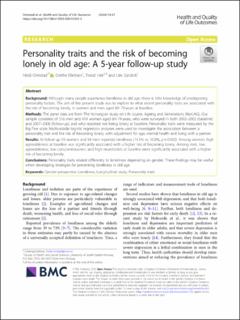Personality traits and the risk of becoming lonely in old age: A 5-year follow-up study
Peer reviewed, Journal article
Published version
Permanent lenke
https://hdl.handle.net/11250/2647015Utgivelsesdato
2020Metadata
Vis full innførselSamlinger
Originalversjon
Health and Quality of Life Outcomes. 2020, 18 (47). https://doi.org/10.1186/s12955-020-01303-5Sammendrag
Background
Although many people experience loneliness in old age, there is little knowledge of predisposing personality factors. The aim of the present study was to explore to what extent personality traits are associated with the risk of becoming lonely, in women and men aged 60–79 years at baseline.
Methods
The panel data are from The Norwegian study on Life course, Ageing and Generations (NorLAG). Our sample consisted of 516 men and 419 women aged 60–79 years, who were surveyed in both 2002–2003 (baseline) and 2007–2008 (follow-up), and who reported not being lonely at baseline. Personality traits were measured by the Big Five scale. Multivariable logistic regression analyses were used to investigate the association between a personality trait and the risk of becoming lonely, with adjustment for age, mental health and living with a partner.
Results
At follow-up 59 women and 54 men reported loneliness (14.1% vs. 10.5%, p = 0.092). Among women, high agreeableness at baseline was significantly associated with a higher risk of becoming lonely. Among men, low agreeableness, low conscientiousness and high neuroticism at baseline were significantly associated with a higher risk of becoming lonely.
Conclusions
Personality traits related differently to loneliness depending on gender. These findings may be useful when developing strategies for preventing loneliness in old age.
Beskrivelse
This article is licensed under a Creative Commons Attribution 4.0 International License, which permits use, sharing, adaptation, distribution and reproduction in any medium or format, as long as you give appropriate credit to the original author(s) and the source, provide a link to the Creative Commons licence, and indicate if changes were made. The images or other third party material in this article are included in the article's Creative Commons licence, unless indicated otherwise in a credit line to the material. If material is not included in the article's Creative Commons licence and your intended use is not permitted by statutory regulation or exceeds the permitted use, you will need to obtain permission directly from the copyright holder.

